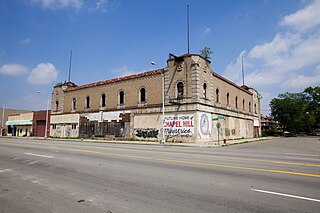
Old Louisville is a historic district and neighborhood in central Louisville, Kentucky, United States. It is the third largest such district in the United States, and the largest preservation district featuring almost entirely Victorian architecture. It is also unique in that a majority of its structures are made of brick, and the neighborhood contains the highest concentration of residential homes with stained glass windows in the U.S. Many of the buildings are in the Victorian-era styles of Romanesque, Queen Anne, Italianate, among others; and many blocks have had few or no buildings razed. There are also several 20th-century buildings from 15 to 20 stories.

Downtown Louisville is the largest central business district in the Commonwealth of Kentucky and the urban hub of the Louisville, Kentucky Metropolitan Area. Its boundaries are the Ohio River to the north, Hancock Street to the east, York and Jacob Streets to the south, and 9th Street to the west. As of 2015, the population of downtown Louisville was 4,700, although this does not include directly surrounding areas such as Old Louisville, Butchertown, NuLu, and Phoenix Hill.

Bowman Field is a public airport five miles (8.0 km) southeast of downtown Louisville, in Jefferson County, Kentucky. The airport covers 426 acres (172 ha) and has two runways. The FAA calls it a reliever airport for nearby Louisville Muhammad Ali International Airport.

Spalding University is a private Catholic university in Louisville, Kentucky. It is affiliated with the Sisters of Charity of Nazareth.
Cincinnatus Shryock was an American architect. A number of his works are listed on the U.S. National Register of Historic Places.
The Pendennis Club is a private social club located at 218 West Muhammad Ali Boulevard in Louisville, Kentucky. It originated as a gentlemen's "city" club on the model of the clubs in London, Britain, of which White's Club founded in 1693 is the progenitor. The Pendennis Club has long been regarded as the preeminent social club in Kentucky and one of the premier clubs in the United States.

The Grande Ballroom is a historic live music venue located at 8952 Grand River Avenue in the Petosky-Otsego neighborhood of Detroit, Michigan. The building was designed by Detroit engineer and architect Charles N. Agree in 1928 and originally served as a multi-purpose building, hosting retail business on the first floor and a large dance hall upstairs. During this period the Grande was renowned for its outstanding hardwood dance floor which took up most of the second floor.

The United States Marine Hospital in Louisville, Kentucky, in the Portland neighborhood was part of the U.S. Marine Hospital system, which was run by the Marine Hospital Service and its successor the Public Health Service, primarily for the benefit of the civilian merchant marine.

The Old Bank of Louisville, also known historically as the Southern National Bank building, is a historic commercial building at 316 West Main Street in downtown Louisville, Kentucky. Completed in 1837, it was designated a National Historic Landmark in 1971 for its exceptionally fine Greek Revival architecture. It currently serves as the lobby for the adjacent Actors Theatre of Louisville.

Louisville, Kentucky is home to numerous structures that are noteworthy due to their architectural characteristics or historic associations, the most noteworthy being the Old Louisville neighborhood, the third largest historic preservation district in the United States. The city also boasts the postmodern Humana Building and an expanding Waterfront Park which has served to remove the former industrial appearance of the riverfront.

Congregation Adath Israel Brith Sholom is a Reform Jewish congregation and synagogue located at 5101 US Hwy 42, in Louisville, Kentucky, in the United States.

St George's Roman Catholic Church is located in Louisville, Kentucky and is a Neo-Baroque church constructed in 1915. It was listed on the National Register of Historic Places (NRHP) in 1982, and the listing was increased in 1996.

The Board of Extension of the Methodist Episcopal Church, South, later known as Methodist Center Building is a historic building at 1115 S. 4th Street in Louisville, Kentucky. The building was constructed in 1915 in a Classical Revival style and added to the National Register of Historic Places in 1983.

The Seelbach Hilton Louisville is a historic hotel in Louisville, Kentucky, United States. Founded by Bavarian-born immigrant brothers Louis and Otto Seelbach, it opened in 1905 as the Seelbach Hotel, and is designed in the French Renaissance style. The hotel has hosted numerous celebrities, including F. Scott Fitzgerald, who took inspiration from the Seelbach for a hotel in The Great Gatsby. The hotel is part of the Hilton Hotels & Resorts chain.

Whiskey Row in Louisville, Kentucky refers to an area along Main Street, close to the Ohio River, which was home to the bourbon industry.

Joseph & Joseph is an architectural firm founded in 1908 in Louisville, Kentucky. The main services include architectural, engineering and design projects.
Luckett & Farley is an architecture, engineering, and interior design firm based in Louisville, Kentucky. It was founded in 1853, making it the oldest continually operating architecture firm in the United States that is not a wholly owned subsidiary. The firm began under the name Rogers, Whitestone & Co., Architects, changing its name to Henry Whitestone in 1857, to D.X. Murphy & Brother in 1890, and to Luckett & Farley in 1962. The company is 100% employee-owned as of January 1, 2012 and concentrates on automotive, industrial, federal government, higher education, health and wellness, and corporate/commercial markets. There are more LEED professionals at Luckett & Farley than any other company in Kentucky with 50, as of December 2012.

The Mercury Ballroom is a music venue in downtown Louisville, Kentucky. The 900-capacity venue, housed in the Wright and Taylor Building at Fourth and Chestnut streets, operated by Live Nation's House of Blues Entertainment division.

Monsieur Giron's Confectionery in Lexington, Kentucky, is a 2-story Greek Revival building constructed of brick in 1829. The building replaced an earlier wood frame building at the site, also occupied by Monsieur Giron's Confectionery. A 50-ft ballroom on the second floor was partitioned by folding doors into two spaces. Originally seven bays wide, only three bays in the north half of the building remain. The building's remnant was added to the National Register of Historic Places (NRHP) in 1974.















